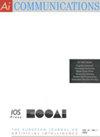Optimizing human hand gestures for AI-systems
IF 1.4
4区 计算机科学
Q4 COMPUTER SCIENCE, ARTIFICIAL INTELLIGENCE
引用次数: 0
Abstract
Humans interact more and more with systems containing AI components. In this work, we focus on hand gestures such as handwriting and sketches serving as inputs to such systems. They are represented as a trajectory, i.e. sequence of points, that is altered to improve interaction with an AI model while keeping the model fixed. Optimized inputs are accompanied by instructions on how to create them. We aim to cut on effort for humans and recognition errors while limiting changes to original inputs. We derive multiple objectives and measures and propose continuous and discrete optimization methods embracing the AI model to improve samples in an iterative fashion by removing, shifting and reordering points of the gesture trajectory. Our quantitative and qualitative evaluation shows that mimicking generated proposals that differ only modestly from the original ones leads to lower error rates and requires less effort. Furthermore, our work can be easily adjusted for sketch abstraction improving on prior work.为人工智能系统优化人类手势
人类与包含人工智能组件的系统的交互越来越多。在这项工作中,我们专注于手势,如手写和草图,作为这些系统的输入。它们被表示为一个轨迹,即点的序列,它被改变以改善与AI模型的交互,同时保持模型的固定。优化的输入伴随着如何创建它们的说明。我们的目标是减少人类的努力和识别错误,同时限制对原始输入的更改。我们推导了多个目标和措施,并提出了包含人工智能模型的连续和离散优化方法,通过移除、移动和重新排序手势轨迹的点,以迭代的方式改进样本。我们的定量和定性评估表明,模仿生成的建议与原始的建议只有适度的不同,导致更低的错误率,需要更少的努力。此外,我们的工作可以很容易地调整草图抽象改进之前的工作。
本文章由计算机程序翻译,如有差异,请以英文原文为准。
求助全文
约1分钟内获得全文
求助全文
来源期刊

AI Communications
工程技术-计算机:人工智能
CiteScore
2.30
自引率
12.50%
发文量
34
审稿时长
4.5 months
期刊介绍:
AI Communications is a journal on artificial intelligence (AI) which has a close relationship to EurAI (European Association for Artificial Intelligence, formerly ECCAI). It covers the whole AI community: Scientific institutions as well as commercial and industrial companies.
AI Communications aims to enhance contacts and information exchange between AI researchers and developers, and to provide supranational information to those concerned with AI and advanced information processing. AI Communications publishes refereed articles concerning scientific and technical AI procedures, provided they are of sufficient interest to a large readership of both scientific and practical background. In addition it contains high-level background material, both at the technical level as well as the level of opinions, policies and news.
 求助内容:
求助内容: 应助结果提醒方式:
应助结果提醒方式:


